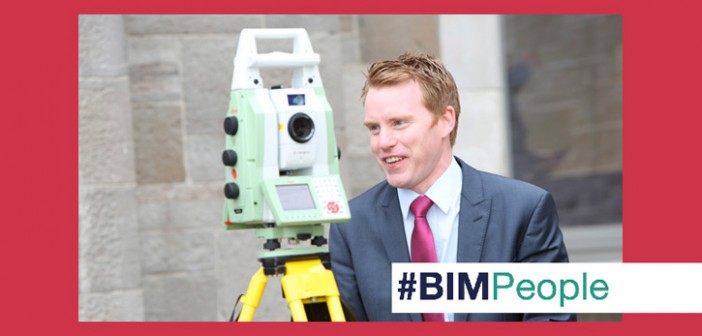John Kerrigan is Leica Geosystems Ireland Manager and the Business Manager for the UK and Ireland for Leica Geosystems UAV Systems. He is responsible for all Leica Geosystems equipment sales in Ireland. He works with distribution partners and directly with customers.
John talked to BIMIreland.ie about his work at Leica Geosystems, its products and BIM in Ireland.
Please tell us why and when you became interested in BIM?
I have always been interested in BIM, I just didn’t realise it was called BIM. All through my career, I have strived to do things the right way, the most efficient way and that is what BIM is all about. BIM is the process and the information is the key. From my days working as a Land Surveyor, I always strived to create the best data so that decisions could be made appropriately from that data. My role now is to provide consultation to my customers and ensure when they are investing in equipment, software and services, that it is right and appropriate for the job they require it for.
Please tell us about Leica Geosystems in Ireland?
Leica Geosystems has a great heritage with over 200 years of creating solutions for professionals to capture, analyse and present spatial information.
Leica Geosystems has had distribution partners in Ireland for over 40 years. I joined Leica Geosystems in 2011 as a Technical Sales Representative. My job was to help deliver our solutions to the marketplace and ensure that our customers were getting the most out of their Leica equipment. I am now the Country Manager of Ireland as well as the Business Manager for the UK and Ireland for Leica Geosystems UAV Systems. I really enjoy my job as I am fortunate to work for a company that continues to bring revolutionary products to the marketplace. Some Irish companies were the first to embrace our Laser Scanning Technology along with our cutting-edge software solutions and that hasn’t changed today. With the release of Jetstream, our latest software revolution that simplifies point cloud access and adds ultra-high-speed rendering, it was an Irish company that invested in it first. They saw immediate benefits, in some cases resulting in a 20% saving on time compared to previous methods.
Could you tell us about your work at Leica Geosystems, and how BIM has changed customers’ demands?
BIM has certainly changed the way people are doing things. Most companies I go to now are talking about managing their data. It is very common for me to be talking to the IT department in large organisations as well as the technical guys in the field. Due to the size of the data sets from laser scanners, the IT infrastructure needs to be up to the task. We can help with our software and advise as much as possible. There are serious demands made of my customers to deliver the most accurate data in the most appropriate fashion. We at Leica Geosystems can help with this due to our best in class hardware and software, and our leading AEC software partnerships. For example, we can seamlessly deliver our scan data to Revit or Navisworks via our Cloudworx plugins.
Please describe the products Leica Geosystems is offering BIM Professionals?
All our equipment is manufactured with the BIM process in mind. We have manufactured the first ever MultiStation, which combines Total Station, GNSS, Imagery and Scanning into one instrument. This can be the ideal tool for any company that needs to gather high-accuracy topographic data and laser scanning point clouds. It is the ideal tool for validation which is so important when talking about BIM.
Our laser scanners are commonplace in so many organisations today for their ability to gather huge amounts of data in a short amount of time. The scans are then registered in our Cyclone software. We have made this step easier with automatic registration a key feature. This data can then be viewed in most authoring software via our Cloudworx products. The most common programmes asked for today are our Cloudworx for Revit with Jetstream. This enables our customers to work seamlessly with the point cloud data in their common working environment.
What products are in big demand? Can you tell us about them?
Our iCON range of total stations is in high demand due to the unique on-board software that makes setting out on site a much easier task. This unit also works with the Point Layout App developed by Autodesk. We are seeing more of an uptake of this option for validation on sites.
Our Captivate range of Total Stations and MultiStations are also very much in high demand. We have really thought about what are our customers’ needs when developing these instruments. We came up with 3 rules, an enjoyable users experience, 3D everything 3D Everywhere and Back to Basics. We want our customers to really enjoy using our equipment and enable them to see their data in 3D in all functions of our software and not make it too difficult to work with. We have definitely achieved all three.
How does demand in Ireland compare to demand in Britain, and other countries?
We are seeing big demands in Ireland and we are continually looking to grow our business. With new products coming to market we see new opportunities. The same can be said in the UK. The big difference at the moment is the size of some of the jobs. We have had recent success delivering surveying and machine control equipment to the Aberdeen bypass project. This is a 58km road that is utilising Machine Control like no other project I have experienced before. There just isn’t that type of project in Ireland. The other big difference is that our big customers in the UK will be mandated to deliver Level 2 BIM from April onwards on a lot of their projects, so have subsequently educated their organisations to be ready for the change. We are getting there with the help of CitA and the drive in Ireland but without the mandate, there is arguably less awareness of BIM and it is main contractors who understand the financial and time benefits that are likely to be the catalyst for wider adoption.
To what degree are customers knowledgeable about the products available?
I believe the Irish customer is probably more knowledgeable about our products than any other country. We as a nation are very well versed in technology and are not afraid of adapting it if it is the right thing to do. In my experience with Leica Geosystems, it has been Irish companies that have pushed us as an organisation to bring more advances in our hardware and software to meet their growing needs. These companies work with us on an ongoing basis, doing beta testing and the likes.
Could you tell us what the company has done to meet interest in BIM?
We have set up a department in our company that is fully focused on BIM, from instrumentation and software to workflows and interoperability. We have worked hard to make strategic partnerships so that data can be accessed and worked on in an appropriate fashion. We have an innovation process that is going to continue to deliver the right products for the marketplace and for our customers.
What advice would you give to a potential customer considering purchasing new equipment?
The customer really needs to understand what the technology can do for them and their organisation. I always strive to be a consultant to my customers. It is my job to sell equipment but more importantly, it is my job to sell the right equipment, at the right time, for the right job. I work with our customers to look at their return on investment and ensure there is real value in the purchase. Time is so important for every organisation so I believe that my equipment has to deliver time savings to companies and this is where they will make their money back.
How do you see surveying technology changing in the next decade?
I get asked quite a lot about what we will see in the next decade. I can see UAV technology advancing and being more beneficial to the day to day task of the profession. Imagery is going to be extremely important and creating point clouds from imagery will be commonplace. There will be more advances in GNSS and how the systems get their corrections. Monitoring is also going to be a given on most projects due to the age of our infrastructure. Saying that, there will always be the need for total stations and GNSS for the areas that are not readily visible and for setting out purposes.
What needs to be done to further encourage BIM adoption in Ireland?
We need to continue to educate the people we are in contact with on a daily basis. BIM is not going away. It will and needs to be the way the AEC professions work. Supporting organisations like CitA is one way. BIM should not be considered a threat but an opportunity. Once this is understood, we will all be in a better place.




